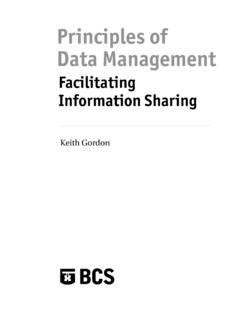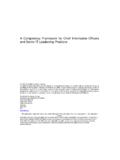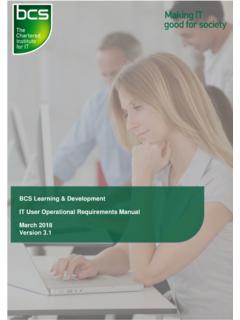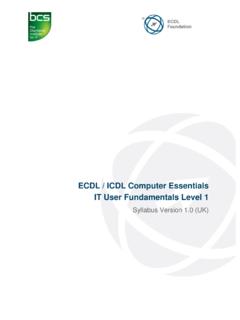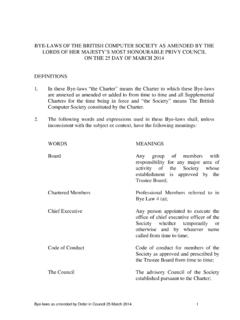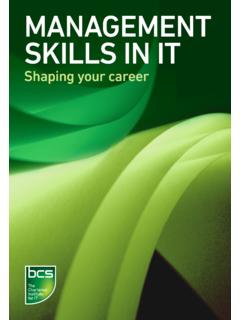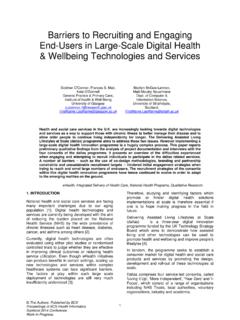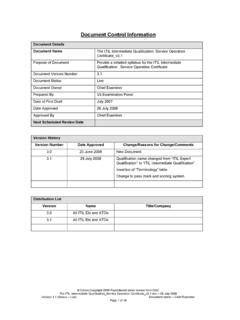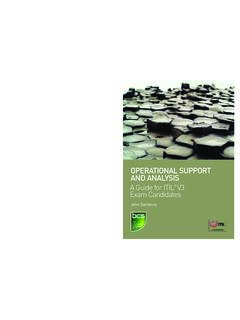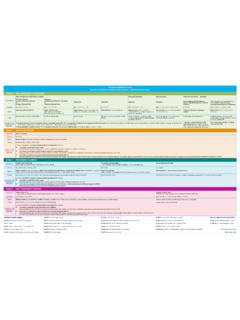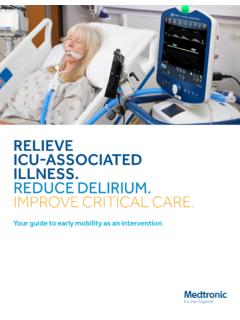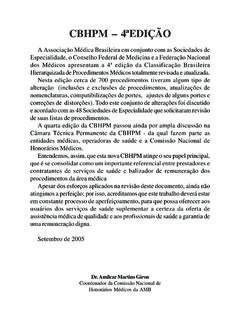Transcription of 9781906124618 Business Analysis Second Edition - …
1 Business Analysisis a bestselling practical guide for anyone involved in Business Analysis , whether improving businessprocesses or defining requirements for IT solutions. The book explores the entire range of approaches and techniques needed to conduct Business Analysis successfully, including investigatingbusiness issues, modelling processes, defining requirements andproducing rigorous Business cases. Some important enhancements to this new Edition : the inclusionof additional techniques such as Ishikawa diagrams and spaghettimaps; expanded treatment of requirements management and investigation of Business needs; more detailed treatment of benefits realisation including the use of benefits realisation maps. New Edition of bestselling book Practical Business Analysis techniques Business process modelling Requirements Analysis and management Managing changeABOUT THE AUTHORSB usiness Analysishas been written and now updated by a team of experts who are practitioners and educators in the businessanalysis field.
2 You might also be interested in: Business Analysis TECHNIQUES72 Essential Tools for SuccessJames Cadle, Debra Paul and Paul Turner Business Analysis Second EDITIONBUSINESS Analysis Second EditionDebra Paul, Donald Yeates and James Cadle (Editors) Business Analysis is an excellent introductory text forbusiness analystsseeking to apply thestandards, knowledgeand competencies ofthe discipline. It goesbeyond most texts toshow how businessanalysts define requirements not only to support IT systems development,but also to drivebusiness change and implement organizational Barret, President & CEO of theInternational Institute of Business AnalysisPaul, Yeates, Cadle (Editors) Business Debra Paul, Donald Yeates and James Cadle (Editors) Business ANALYSISS econd Editionbusiness- Analysis -2e-artwork-ma_L ayout 1 24/06/2010 14:53 Page 1 Business Analysis Second Edition_Layout 1 6/25/10 4:37 PM Page iBUSINESS Analysis Second EditionBusiness Analysis Second Edition_Layout 1 6/25/10 4:37 PM Page iBCS The Chartered Institute for ITOur mission as BCS, The Chartered Institute for IT, is to enable the information society.
3 We promote wider social and economic progress through the advancementof information technology science and practice. We bring together industry, academics, practitioners and government to share knowledge, promote new thinking, inform the design of new curricula, shape public policy and inform the vision is to be a world-class organisation for IT. Our 70,000 strong membership includes practitioners, businesses, academics and students in the UK and internationally. We deliver a range of professional development tools for practitioners and employees. A leading IT qualification body, we offer a range of widely recognised InformationBCS The Chartered Institute for IT, First Floor, Block D, North Star House, North Star Avenue, Swindon, SN2 1FA, United +44 (0) 1793 417 424F +44 (0) 1793 417 Analysis Second Edition_Layout 1 6/25/10 4:37 PM Page iiBUSINESS Analysis Second EditionEDITED BYDebra Paul, Donald Yeates and James CadleBusiness Analysis Second Edition_Layout 1 6/25/10 4:37 PM Page iiiiv 2010 British Informatics Society LimitedAll rights reserved.
4 Apart from any fair dealing for the purposes of research or private study, or criticism orreview, as permitted by the Copyright Designs and Patents Act 1988, no part of this publication may be reproduced, stored or transmitted in any form or by any means, except with the prior permission in writingof the publisher, or in the case of reprographic reproduction, in accordance with the terms of the licencesissued by the Copyright Licensing Agency. Enquiries for permission to reproduce material outside thoseterms should be directed to the trade marks, registered names etc. acknowledged in this publication are the property of their respectiveowners. BCS and the BCS logo are the registered trade marks of the British Computer Society charity number 292786 (BCS).Published by British Informatics Society Limited (BISL), a wholly owned subsidiary of BCS The Chartered Institute for IT, First Floor, Block D, North Star House, North Star Avenue, Swindon, SN2 1FA, United Kingdom. 978-1-906124-61-8 British Cataloguing in Publication CIP catalogue record for this book is available at the British :The views expressed in this book are of the author(s) and do not necessarily reflect the views of BISL or BCSexcept where explicitly stated as such.
5 Although every care has been taken by the authors and BISL in thepreparation of the publication, no warranty is given by the authors or BISL as publisher as to the accuracy orcompleteness of the information contained within it and neither the authors nor BISL shall be responsible orliable for any loss or damage whatsoever arising by virtue of such information or any instructions or advicecontained within this publication or by any of the by Lapiz Digital Services, Chennai, at CPI Antony Rowe Ltd., Chippenham, Analysis Second Edition_Layout 1 6/25/10 4:37 PM Page ivvList of figures and tables ixContributorsxiiForewordxiiiAbbreviatio ns xivGlossary xviPrefacexxvii1 WHAT IS Business Analysis ?1 Introduction1 The origins of Business analysis2 The development of Business analysis2 The scope of Business Analysis work5 The role and responsibilities of a Business analyst10 The Business Analysis maturity model12 The future of Business analysis14 References15 Further reading15 Useful websites152 THE COMPETENCIES OF A Business ANALYST16 Introduction16 Behavioural skills and personal qualities17 Business knowledge20 Techniques23 The right competencies for the right situation25 How can I develop my competencies?
6 26 Industry skills frameworks27 Industry qualifications 31 Summary32 References33 Further reading33 Useful websites343 STRATEGY ANALYSIS35 Introduction 35 The context for strategy35 What is strategy?37 Strategy development38 External environment analysis41 Internal environment analysis46 CONTENTSB usiness Analysis Second Edition_Layout 1 6/25/10 4:37 PM Page vSWOT analysis48 Implementing strategy50 Summary53 References53 Further reading534 THE Business Analysis PROCESS MODEL55 Introduction55An approach to problem-solving55 The process model57 Investigating the situation58 Considering perspectives60 Analysing needs62 Evaluating options64 Defining requirements65 Delivering changes67 Summary69 References69 Further reading705 INVESTIGATION TECHNIQUES 71 Introduction 71 Prior research71 Investigation techniques73 Quantitative approaches88 Documenting the current Business situation91 Summary97 References97 Further reading976 STAKEHOLDER Analysis AND MANAGEMENT99 Introduction99 Stakeholder categories and identification100 Analysing stakeholders102 Stakeholder management strategies103 Managing stakeholders106 Stakeholder views108 Defining stakeholder involvement RACI and RASCI charts108 Summary111 Further reading1117 MODELLING Business SYSTEMS112 Introduction112 Soft systems methodology113 Business perspectives115
7 Business activity models117 Business events and Business rules122 Critical success factors and key performance indicators124 Validating a Business activity model124 Use of the Business activity model in gap analysis124viCONTENTSB usiness Analysis Second Edition_Layout 1 6/25/10 4:37 PM Page viSummary125 References125 Further reading1258 MODELLING Business PROCESSES127 Introduction127 Organisational context127An alternative view of an organisation 129 The organisational view of Business processes130 Value propositions133 Business process models136 Analysing the Business process model140 Improving Business processes141 Process measurement143 Six Sigma146 Summary147 References147 Further reading147 Useful websites 1489 GATHERING THE REQUIREMENTS149 Introduction149 The problems with requirements149A process for requirements engineering152 Actors153 Requirements elicitation156 Building the requirements list 161 Requirements Analysis 162 Validating requirements165 Summary166 References167 Further reading16710 DOCUMENTING AND MANAGING REQUIREMENTS168 Introduction168 The importance of documentation168 The requirements document168 The requirements catalogue170 Managing requirements179 Conclusion185 Further reading18511 MODELLING REQUIREMENTS186
8 Introduction186 Modelling system functions186 Modelling system data190 Class models199 Summary204 References205 Further reading205viiCONTENTSB usiness Analysis Second Edition_Layout 1 6/25/10 4:37 PM Page vii12 DELIVERING THE REQUIREMENTS206 Introduction206 Delivering the solution206 Context207 Delivery lifecycles208 Approach215 Roles in delivering requirements219 Deliverables220 Techniques220 Conclusion221 References221 Further reading22113 MAKING A Business AND FINANCIAL CASE223 Introduction223 The Business case in the project lifecycle223 Identifying options224 Assessing project feasibility226 Structure of a Business case229 Investment appraisal237 Presentation of a Business case239 Benefits management and realisation240 Summary243 Further reading24314 IMPLEMENTING Business CHANGE244 Introduction244 Introducing a new Business system244 The nature of change245 The environment for change 246 Alignment252 Definition256 Design258 Implementation259 Realisation264 Conclusion267 References267 Further reading268 Index269viiiCONTENTSB usiness Analysis Second Edition_Layout 1 6/25/10 4.
9 37 PM Page viiiixFigure change lifecycle 4 Figure range of the Business analyst role6 Figure four views of a Business system9 Figure Business Analysis maturity model12 Figure capability maturity model integration13 Figure competencies of a Business analyst17 Figure Analysis matrix25 Figure creation39 Figure s five forces model44 Figure Boston box48 Figure of a SWOT matrix49 Figure McKinsey 7-S model51 Figure balanced Business scorecard52 Figure problem-solving model56 Figure Business Analysis process model58 Figure Business Analysis process model68 Figure STOP , the organisation hierarchy76 Figure structure of an interview77 Figure techniques83 Figure for developing scenarios85 Figure of a rich picture 92 Figure of a mind map93 Figure of a spaghetti map for a garage service section94 Figure of a fishbone diagram 96 Figure management in the project lifecycle99 Figure stakeholder categories100 Figure power/interest analysis103 Figure stakeholder management strategies104 Figure of a RACI chart109 Figure of a RASCI chart110 Figure s soft systems methodology114 Figure notation using cloud symbols119 Figure for a travel company120 Figure event triggering activities123 Figure view of an organization128 Figure model (after Harmon 2007)129 Figure process receiving input and producing output131 Figure process model131 Figure process map for a library service132 LIST OF FIGURES AND TABLESB usiness Analysis Second Edition_Layout 1 6/25/10 4.
10 37 PM Page ixFigure s value chain133 Figure value-chain activities for a manufacturing organisation 134 Figure of a value proposition134 Figure process model for Loan item process137 Figure process Loan item with alternative paths138 Figure process model with link from another process138 Figure example of handoffs on the high-level process model140 Figure example of a Business process with a timeline145 Figure engineering process152 Figure to explicit knowledge160 Figure of a requirement document169 Figure of requirements171 Figure of requirements172 Figure catalogue example180 Figure of requirements management181 Figure use case diagram for a project control system187 Figure case diagram showing <<include>>188 Figure case diagram showing <<include>> and <<extend>>189 Figure showing one-to-many relationship191 Figure showing a one-to-one relationship192 Figure showing a fully mandatory one-to-many relationship 193 Figure showing a fully optional one-to-many relationship193 Figure mandatory parent entity with optional child entities194 Figure optional parent entity with mandatory child entities194 Figure showing a many-to-many relationship195 Figure showing a resolved many-to-many relationship195 Figure relationship between entities196 Figure relationships196 Figure entity relationship diagram for a sales system197 Figure data modelling notation198 Figure of the class Account 200 Figure association between two classes201 Figure association with one-to-many multiplicity201 Figure association with one-to-zero-to-one multiplicity 201 Figure association with one-to-one-to-many multiplicity 202 Figure association with one-to-one-to-20 multiplicity202 Figure association with many-to-many multiplicity 203 Figure association class 203 Figure generalisation structure 204 Figure in deciding the delivery approach207 Figure change lifecycle209
